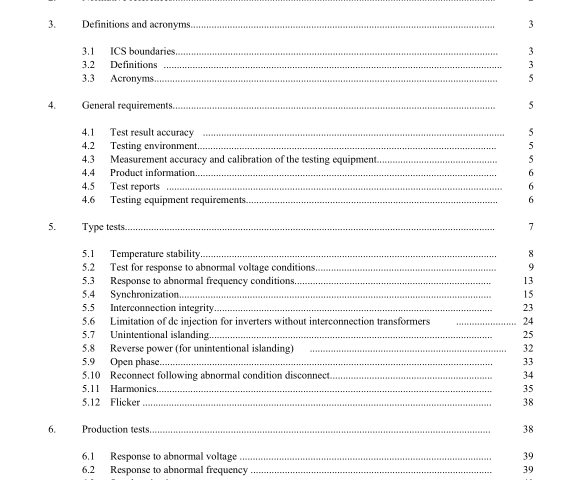IEEE 1547.1-2005 pdf download.IEEE Standard Conformance Test Procedures for Equipment Interconnecting Distributed Resources with Electric Power Systems
4. General requirements
Implementation of these test procedures shall be conducted in accordance with appropriate safety procedures, sequences, and precautions.
4.1 Test result accuracy
The test results shall verify that the equipment under test (EUT) meets the requirements of IEEE Std 1547 within the manufacturer’s specified accuracy.
4.2 Testing environment
The manufacturer shall specify the range of environmental conditions for the EUT. Therefore, tests shall be conducted in an environment that is within the manufacturer’s specified environmental operating conditions.
4.3 Measurement accuracy and calibration of the testing equipment
Measurement equipment used to confirm performance of an EUT shall have calibration traceablity. The accuracy of the measuring equipment shall be suitable for the test being conducted.
4.4 Product information
The setting of limits and the structure of this standard are based on the understanding that the installer and user are responsible for following the installation recommendations of the manufacturer.
The manufacturer shall supply the EUT tester with documentation necessary for the correct installation into a typical system or process in the intended environment. A functional description and a definition of specifi- cation limits for the acceptance criteria shall be provided by the manufacturer and noted in the test report. Any external devices or equipment or special connection requirements necessary to conduct the tests shall be clearly stated (including rationale) in the user documentation. Special requirements can include the amount of network impedance, voltampere burden of the EUT, the use of shielded or special cables, maxi- mum cable length, the use of filters, and the correct bonding to functional earth (grounding).
If different devices or connection requirements apply in different environments, this shall also be stated. A list of auxil- iary equipment (e.g., options or enhancements) that can be added to the EUT and that can impact the result of EUT tests shall be made available.
This information shall also be covered in the test report to clarify the as-tested arrangement(s).
Accuracy and tolerances of device parameters shall be stated by the manufacturers.
4.5 Test reports
The test results shall be documented in a test report. The report shall clearly and unambiguously present all relevant information of the tests (e.g., load conditions, conductor type or routing, functional description,acceptance criteria).
Within the test report, test procedures, as performed, shall be detailed; and engineering considerations,including test modifications and exemptions, shall be justified. When used in conjunction with this standard,the test report shall include sufficient critical operating information to rerun the test and reproduce the results.
Each test method shall be specified; and engineering considerations, including range of operating conditions, shall be justified.
4.6 Testing equipment requirements
4.6.1 Simulated area EPS (utility) source requirements
Where testing allows the use of a simulated area EPS source, the following requirements shall be met:
The simulated area EPS source shall be capable of confirming the manufacturer’s stated
performance.
The voltage harmonics of the simulated area EPS source shall be less than 2.5% total harmonic distortion (THD).
The individual voltage harmonics of the simulated utility shall be less than 50% of the limits in Table 3 of IEEE Std 1547.
During the tests, the steady-state voltage of the simulated area EPS source shall not vary by more than ± 1% of the nominal voltage.
For voltage trip magnitude tests, the voltage change resolution of the simulated utility source shall be within 0.5 a of the nominal voltage, where a is the manufacture’s stated accuracy.
For frequency trip magnitude tests, the frequency change resolution of the simulated utility source shall be within 0.5 a of the nominal frequency, where a is the manufacture’s stated accuracy.IEEE 1547.1 pdf download.IEEE 1547.1-2005 pdf download
IEEE 1547.1-2005 pdf download

Leave a Reply